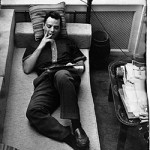Organizing your rhymes is like organizing your stanzas. The first rhyme you hear is “a,” the second is “b,” the third is “c,” and so on. If you repeat a stanza of music, you should use the same pattern of rhymes. The most common combinations are those that rely on repetition (aaaa, aabb) and those that rely on variation (abab, abba).
Two forms that use repetition are “monorhyme” (aaaa) and “rhyming couplets” (aabb). An example of monorhyme is Stephen Sondheim’s “America” from West Side Story.
I like to be in America (a)
Okay by me in America (a)
Everything free in America (a)
For a small fee in America (a)
An example of rhyming couplets is Oscar Hammerstein II’s “My Favorite Things” from The Sound of Music.
Girls in white dresses with blue satin sashes (a)
Snowflakes that stay on my nose and eyelashes (a)
Silver white winters that melt into springs (b)
These are a few of my favorite things (b)
Two forms that use variation are “alternate rhyme” (abab) and “enclosed rhyme” (abba). An example of alternate rhyme is Herbert Kretzmer’s “I Dreamed a Dream” from Les Misérables.
Then I was young and unafraid (a)
And dreams were made and used and wasted (b)
There was no ransom to be paid (a)
No song unsung, no wine untasted (b)
An example of enclosed rhyme is Howard Ashman’s “Beauty and the Beast” from Beauty and the Beast.
Certain as the sun rising in the east (a)
Tale as old as time (b)
Song as old as rhyme (b)
Beauty and the beast (a)
That’s the basics of lyrics. For inspiration, browse Sondheim’s two-volume set from 2011, Finishing the Hat (1954-81) and Look, I Made a Hat (1981-2011), with his “attendant comments, principles, heresies, grudges, whines and anecdotes.” Also check your local library’s e-book and audiobook services for Hammerstein’s Lyrics (1949), with his essay “Notes on Lyrics”; Ira Gershwin’s Lyrics on Several Occasions (1959), with “informative annotations” on how he wrote; and Robert Gottlieb’s Reading Lyrics (2000), with more than 1,000 lyrics, many from musicals.
For exercises in lyric writing, try The Making of a Musical (1977) by Lehman Engel, with assignments from his legendary workshop that taught writers from Lynn Ahrens to Maury Yeston — and inspired the musical A Class Act: A Musical About Musicals, based on the life of A Chorus Line lyricist Ed Kleban. To learn about Broadway’s major lyric writers, look for Word Crazy (1991) by Thomas Hischak.
Vocabulary from this week: comparison, wordplay that compares two things, such as metaphor (directly comparing) and simile [SIM-uh-lee] (indirectly comparing using “like” or “as”); eleven o’clock number, the song at the climax; false rhyme (imperfect rhyme), where only the final vowel or consonant sounds match, such as assonance (vowel sounds) and consonance (consonant sounds); onomatopoeia [on-uh-mah-tuh-PEE-uh], playing with word sounds; portmanteau [port-man-TOE], playing with word blends; pun, playing with word meanings; reprise [reh-PREEZ], a repeated song that reveals a plot development; rhyme scheme, the pattern of repeated and varied rhymes, such as monorhyme (aaaa), rhyming couplets (aabb), alternate rhyme (abab), and enclosed rhyme (abba); song form, the pattern of similar and contrasting sections, such as AAA (verse form), AABA (ballad form), ABAB (verse-chorus form); and true rhyme (perfect rhyme), where both the final vowel and consonant sounds match.
Next, the rhythm.

